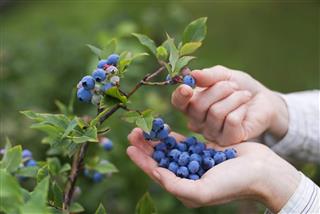
Cross-pollination is defined as the transfer of pollens from one flower to another of a different plant. Some examples of plants that exhibit this phenomenon are cucurbits, blueberries, cherry trees and apple trees.
Amongst sexually reproducing plants or flowering plants, pollination is the key process for fertilization. It is defined as the transfer of pollens from the anther to stigma, either in the same plant or to a different plant. When pollens are delivered to the same flower or different flower of the similar plant, it is known as self pollination or autogamy. Contrary to this, a flower is pollinated by pollens of a different plant’s flower in cross-pollination. As ovum and spermatozoa come from different plants, it is also referred to as allogamy.
What is Cross-Pollination?
Most of us are well acquainted with cross-pollination definition, which states it as, the transfer of pollens from the male reproductive organ (stamen bearing anther) to the female reproductive part (pistil bearing stigma), of a different plant. In the phenomenon, the pollens containing male gametes or sperms are deposited in the receptive part of a flower, from which they are channeled to the female gamete or ovule. In gymnosperms, pollens are directly deposited in the micropyle of the ovule; whereas, pollens are collected by the stigma in angiosperms.
In cross-pollination, the pollinating agents play a crucial role in carrying out fertilization. Hence, for it to take place, there should be prospective agents, which may be biotic pollinators (e.g. insects, birds) or abiotic factors (e.g. wind, water). The biotic pollination contributes to more than 80 percent of fertilization cases. An adaptation in cross-pollinated plants is bearing of stamens that are taller than the ovule bearing structures called pistils. Usually, the flowers have colorful petals and strong fragrance to attract cross pollinating agent.
Examples
The major benefit of cross-pollination is giving rise to offspring that are genetically different from the parent plants. Thus, plant hybrids with desirable characters are produced as a result of it. In nature, it increases the survival rate of plants. In plant breeding experiments, flowers of various plant species are cross-pollinated manually. All you need is a collection of the pollens at a specific time and place them into stigma of another plant of the same species.
Cucurbits: At times, cross-pollination takes place between two related species, though they are not identical to each other. An example is pollination between zucchini and acorn squash, both of which belong to the Cucurbitaceae family. In short, plants classified under the same botanical species can be cross-pollinated successfully.
Blueberries: Cross-pollination of fruit trees is studied in detail, as it indirectly affects the fruit production. In case of blueberries, bumble bees and other bee types, pollinate the flowers. For production of larger berries and also to ensure good yield, grow different cultivars of blueberries. Nevertheless, while selecting the varieties, make sure that they are compatible to each other.
Cherry Trees: Sweet cherry cultivars are cross-pollinated species, while sour varieties undergo self pollination. This is the main reason why, fruits cultivators often grow many cherry trees (that bloom at the same time) in proximity to each other. For planting in your orchard, choose compatible cherry species by consulting your local horticulturist.
Apple Trees: Another example of cross-pollination in fruits trees is apple. For a flower to produce apple fruit, it has to be fertilized by pollen of another flower from a different apple plant. In this process, honey bees land on the apple flower, collect nectar and pollens, and then visit another flower. Thus, the pollens are carried to another flower of a different tree, resulting in cross-pollination.
The end result is fertilization, which is followed by formation of seeds in the ovule. This is the main difference concerning pollination vs. fertilization. A major concern in agriculture and horticulture industries is loss of biotic pollinators in the last few decades. This pollinator decline leads to reduced rate of cross-pollination of flowers. Consequently, fertilization is affected negatively, which in turn causes decrease in fruit yield and crop production. The probable reasons for loss of pollinators are application of pesticides, insecticides, and habitat destruction.



